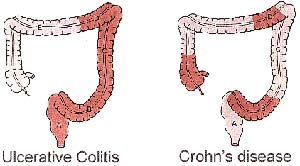What are the Symptoms of Ulcerative Colitis?
Common symptoms of ulcerative colitis include rectal bleeding and diarrhea, but there is a wide range of symptoms among patients with this disease. Variability of symptoms reflects differences in the extent of disease (the amount of the colon and rectum that are inflamed) and the intensity of inflammation. Generally, patients with inflammation confined to the rectum and a short segment of the colon adjacent to the rectum have milder symptoms and a better prognosis than patients with more widespread inflammation of the colon. The different types of ulcerative colitis are classified according to the location and the extent of inflammation:
· 1. Ulcerative proctitis refers to inflammation that is limited to the rectum. In many patients with ulcerative proctitis, mild intermittent rectal bleeding may be the only symptom. Other patients with more severe rectal inflammation may, in addition, experience rectal pain, urgency (sudden feeling of having to defecate and a need to rush to the bathroom for fear of soiling), and tenesmus (ineffective, painful urge to move one"s bowels).
· 2. Proctosigmoiditis involves inflammation of the rectum and the sigmoid colon (a short segment of the colon contiguous to the rectum). Symptoms of proctosigmoiditis, like that of proctitis, include rectal bleeding, urgency, and tenesmus. Some patients with proctosigmoiditis also develop bloody diarrhea and cramps.
· 3. Left-sided colitis involves inflammation that starts at the rectum and extends up the left colon (sigmoid colon and the descending colon). Symptoms of left-sided colitis include bloody diarrhea, abdominal cramps, weight loss, and left-sided abdominal pain.
· 4. Pancolitis or universal colitis refers to inflammation affecting the entire colon (right colon, left colon, transverse colon and the rectum). Symptoms of pancolitis include bloody diarrhea, abdominal pain and cramps, weight loss, fatigue, fever, and night sweats. Some patients with pancolitis have low-grade inflammation and mild symptoms that respond readily to medications. Generally, however, patients with pancolitis suffer more severe disease and are more difficult to treat than those with more limited forms of ulcerative colitis.
· 5. Fulminant colitis is a rare but severe form of pancolitis. Patients with fulminant colitis are extremely ill with dehydration, severe abdominal pain, protracted diarrhea with bleeding, and even shock. They are at risk of developing toxic megacolon (marked dilatation of the colon due to severe inflammation) and colon rupture (perforation). Patients with fulminant colitis and toxic megacolon are treated in the hospital with potent intravenous medications. Unless they respond to treatment promptly, surgical removal of the diseased colon is necessary to prevent colon rupture.
· While the intensity of colon inflammation in ulcerative colitis waxes and wanes over time, the location and the extent of disease in a patient generally stays constant. Therefore, when a patient with ulcerative proctitis develops a relapse of his disease, the inflammation usually is confined to the rectum. Nevertheless, a small number of patients (less than 10%) with ulcerative proctitis or proctosigmoiditis can later develop more extensive colitis. Thus, patients who initially only have ulcerative proctitis can later develop left-sided colitis or even pancolitis. What are the Symptoms of Ulcerative Colitis?
Common symptoms of ulcerative colitis include rectal bleeding and diarrhea, but there is a wide range of symptoms among patients with this disease. Variability of symptoms reflects differences in the extent of disease (the amount of the colon and rectum that are inflamed) and the intensity of inflammation. Generally, patients with inflammation confined to the rectum and a short segment of the colon adjacent to the rectum have milder symptoms and a better prognosis than patients with more widespread inflammation of the colon. The different types of ulcerative colitis are classified according to the location and the extent of inflammation:



